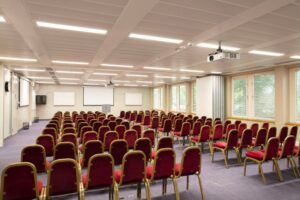
How to Choose the Right Meeting Room Style
Meetings bear substantial significance for a multitude of reasons. They assume a pivotal role in strengthening team connections and providing allocated moments for communication – an irreplaceable asset in any business or professional setting. These assemblies offer a chance for team members to unite, fostering productive idea-sharing and collaboration. This blog delves into a crucial aspect of event planning for such meetings: choosing the perfect meeting room style for your conference.
The success of a conference depends not just on the content delivered but also on the environment for attendees. Whether it’s a formal business conference, educational seminar, or networking event, the meeting room setup style you choose can affect engagement, collaboration, and communication among participants.
In this guide, we’ll explore meeting room styles, offering insights to aid your decision. This knowledge will help align conference goals with the right meeting room style for a seamless and impactful event. Let’s delve into meeting room styles and key considerations, empowering your choice for the upcoming conference.
Steps to Choosing the Right Meeting Room Style:
1. Define Your Requirements
Identify the key requirements for your conference, such as the number of attendees, seating arrangements, technical equipment (projectors, screens, microphones), and any specific layout preferences (theatre style, classroom style, U-shape, etc.).
2. Set a Budget
Determine how much you’re willing to spend on the meeting room, taking into account other expenses like catering, AV equipment, decorations, and marketing materials.
3. Location
Choose a convenient and accessible location that is easily reachable for your attendees. Consider factors like proximity to transportation hubs, parking availability, and nearby accommodation.
4. Capacity
Ensure that the meeting room can comfortably accommodate the expected number of attendees. Avoid selecting a room that’s too small and crowded or too large and empty, as both scenarios can negatively impact the conference experience.
5. Layout and Seating
Decide on the desired seating arrangement based on the nature of the conference. Choose a venue with flexible room arrangements. Different layouts (theatre style, classroom style, boardroom style, etc.) cater to different types of interactions and presentations.
6. Technical Facilities
Check if the meeting room is equipped with the necessary technical facilities, such as projectors, screens, audio systems, microphones, and reliable Wi-Fi. Test these facilities beforehand to ensure they work properly.
7. Ambience and Atmosphere
Consider the ambience of the meeting room. Is it conducive to the type of conference you’re organising? Is it well-lit and comfortable? The atmosphere can greatly influence attendees’ engagement and overall experience.
8. Catering Services
If you’re planning to provide food and beverages, ensure the meeting room can accommodate catering services. Some venues have in-house catering, while others allow external catering.
9. Flexibility
Look for a meeting room that offers flexibility in terms of setup changes and timing adjustments, in case you need to make last-minute modifications.
10. Aesthetics
The aesthetics of the meeting room matter. Does it align with your conference’s theme or branding? A well-decorated and visually appealing room can leave a positive impression.
11. Accessibility
Ensure the meeting room is accessible to all attendees, including those with mobility challenges. Check for features like ramps, elevators, and accessible restrooms.
12. Parking and Transportation
Consider the availability of parking spaces and nearby transportation options for attendees who might be commuting.
13. Reviews and Recommendations
Look for reviews or testimonials from others who have used the meeting room for similar events. Their experiences can provide valuable insights into the venue’s suitability.
14. Visit the Venue
Whenever possible, visit the venue in person before making a final decision. This will give you a firsthand experience of the space and help you identify any potential issues.
15. Negotiate and Book in Advance
Once you’ve found the right meeting room for your meeting or conference, negotiate the terms and conditions, including rental costs and any additional services. Booking well in advance ensures you secure the desired date and time.
Remember that the success of your conference is influenced by the choice of meeting room, so take your time to research and make an informed decision. Now you know the necessary steps in choosing the right meeting room style, let’s run through all the different styles available.
What Conference Room Styles Are Available?

There are several conference room styles available, each designed to cater to different types of meetings and interactions. Choosing the right style depends on the objectives of your meeting and the desired level of engagement among participants. Here are some common conference room styles and how to choose the right one for your meeting:
1. Theatre Style
This style features rows of chairs facing a stage or presentation area. It’s ideal for large presentations or lectures where participants are primarily listening and taking notes. This layout maximises seating capacity but limits interaction between participants.
Choose this meeting room style when: You have a large audience and the main focus is on one or more speakers delivering presentations.
2. Classroom Style
Tables and chairs are arranged in rows, similar to a traditional classroom. This setup allows for note-taking and limited interaction, making it suitable for training sessions, workshops, and educational seminars.
Choose this meeting room style when: Your meeting involves training, workshops, or educational sessions where participants need to take notes and engage with the presenter.
3. U-Shape Style
Tables and chairs are arranged in the shape of a “U,” with the open end facing the presenter. This layout encourages interaction and discussion among participants. This meeting room style is suitable for small to medium-sized meetings, discussions, and collaborative sessions.
Choose this meeting room style when: You want to facilitate open discussions, encourage interaction, and promote a collaborative atmosphere among participants.
4. Boardroom Style
A large, long table is surrounded by chairs, creating a formal setup. This style is commonly used for executive meetings, decision-making discussions, and small group interactions.
Choose this meeting room style when: You have a small group of participants who need to have focused discussions, make decisions, and engage in detailed conversations.
5. Banquet or Round Table Style
Round tables are set up with chairs around them, often used for meals or small-group discussions. This setup fosters more intimate conversations and can be used for networking events, breakout sessions, or team-building activities.
Choose this meeting room style when: You want to encourage networking, facilitate small group discussions, or create a more relaxed and social atmosphere.
Our sister brand Lime Venue Portfolio recently did this at their ‘Meeting of the Future Roundtable Discussion: The Meetings Show 2023’.
6. Hollow Square Style
Tables are arranged in a square shape with an open space in the centre. This setup is great for medium-sized meetings or discussions where participants need to interact with each other and the presenter.
Choose this style when: You want to encourage interaction among participants, create a balanced discussion environment, and provide a clear view of the presenter.
7. Cluster or Cabaret Style
Round tables are arranged with chairs on one side, allowing participants to face the front while still having space for materials and note-taking. This style combines elements of theatre and U-shape styles, suitable for presentations with some group interaction.
Choose this meeting style when you want to balance presentations with small group discussions and activities, while still maintaining a focus on the front.
Choosing the Right Meeting Room Style Conclusion
In conclusion, choosing the right meeting room style is a pivotal decision impacting your conference’s success. Each style has unique benefits, catering to different meeting types, and fostering engagement, interaction, and collaboration. Consider content, attendees, and participation level when choosing the right meeting room style.
Take the time to assess the specific requirements of your event, the type of interactions you want to encourage and try to envision the overall atmosphere you aim to create. Keep these insights in mind for a successful and engaging conference that leaves a lasting impact on all participants.
Go back to other articles

